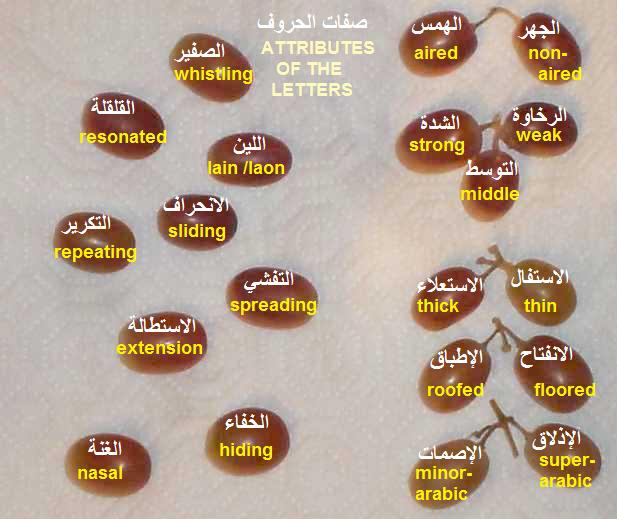
Attributes Without Opposites
Salam alaikum wa rahmatu Allahi wa BarakatuHu.
Peace be upon the followers of guidance.

ATTRIBUTES WITHOUT OPPOSITES:
There are other attributes that are on some of the letters.
A. AsSafeer الصفير - Whistling letter.
B. qalqala القلقلة - resonated letter.
C. leen اللين - Leen letter.
D. AlInhiraf الانحراف - Sliding letter.
E. AlTaqreer التكرير - Repeating letter.
F. Atafashee التفشي - Spreading letter.
G. Alistatala الاستطالة - Extension letter.
H. Alkhafaa الخفاء - hiding letter
I. Alghunna الغنة - nasal letter
A. AsSafeer الصفير
AsSafeer الصفير - Linguistically means a sound that sound like a sound of
a bird. In terminology it refers to the excess sound that comes out between
the lips. It is given the name AsSafeer الصفير because it sounds like a
whistling bird. There are three letters:
" س ص ز "
Repeat after the following ayats paying attention to the AsSafeer الصفير .
{مِن شَرِّ ٱلۡوَسۡوَاسِ ٱلۡخَنَّاسِ}
{ٱهۡدِنَا ٱلصِّرَٲطَ ٱلۡمُسۡتَقِيمَ}
{وَوَضَعۡنَا عَنكَ وِزۡرَكَ}
B. qalqala القلقلة
Qalqala القلقلة linguistically means movement and commotion. In terminology it
refers to the commotion of the emmision point, in the pronounciation of the letter,
until it is stressed. There are five letters in the saying:
"قطب جد".
The reason for this commotion and movement because these letters
have the attributes of both Jahr الجهر and Shiddat الشدة. Jahr الجهر prevents
the air from flowing, and Shiddat الشدة prevents the sound from flowing.
When these two attributes are combined, it becomes neccessary to clarify
it.
Qalqala القلقلة has three levels:
1. The highest level, when stopping on a qalqala letter that has a
shaddah like:
{تَبَّتۡ يَدَآ أَبِى لَهَبٍ۬ وَتَبَّ}
2. Stopping on a qalqala letter without a shaddah
shaddah like:
{وَمِن شَرِّ حَاسِدٍ إِذَا حَسَدَ}
3. The qalqalah letter has a sakinah that is connecting to the next letter, i.e. without stopping on it like:
{أَلَمۡ يَجۡعَلۡ كَيۡدَهُمۡ فِى تَضۡلِيلٍ۬}
C. leen اللين
leen اللين -linguistically is opposite of hardness. In terminology it
means emitting the letter with easiness without hardship. There are
two leen letters, و (wow) and ي (ya) sakinah, that is preceded by a letter that has a
fat'ha, like: خَوْفٌ ، بَيْتٍ.
Allah willing, we will cover more about leen, and how long to pronounce it in a future lesson, in the section of mudood.
Here is an example of leen, Repeat after the following:
{فَلۡيَعۡبُدُواْ رَبَّ هَـٰذَا ٱلۡبَيۡتِ}
D. AlInhiraf الانحراف
AlInhiraf الانحراف linguistically means drifting. In terminology, drifting
the letter from its emmision point to another emission point. There are
two letters ل (lam) and ر (raa). The ل (lam) drifts to the tip of the tongue.
The ر (raa) drifts to the outer part of the tongue, towards the direction
of the ل (lam).
E. AlTaqreer التكرير
AlTaqreer التكرير - linguistically means repeating something after another.
In terminology it means vibrating the tongue in the pronounciation of a letter.
This attribute is neccesary for the ر (raa), in order to pronounce it. However
it should not be continuously repeated so as to trill or roll the ر (raa).
Listen to the following ayat from surah fatiha:
{ٱلرَّحۡمَـٰنِ ٱلرَّحِيمِ}
Listen to the pronounciation trilled:
{ٱلرَّحۡمَـٰنِ ٱلرَّحِيمِ} (TRILLED)
F. Atafashee التفشي -
Atafashee التفشي - - linguistically means spreading.
In terminology it means spreading air throughout the mouth in the
pronounciation of the letter ش (sheen). This attribute is given only to
one letter ش (sheen), as explained by shaikh Aljazaree, may Allah
have mercy on him. There are some ulema that ascribe this
attribute to other letters as well.
Here is an example of Atafashee التفشي, Repeat after the following:
{وَٱلشَّمۡسِ وَضُحَٮٰهَا}
{أَلَمۡ نَشۡرَحۡ لَكَ صَدۡرَكَ}
G. Alistatala الاستطالة-
Alistatala الاستطالة linguistically means extending. In terminology it
refers to extending the sound from the beginning of the side of the
tongue to the end, and this the attribute of the letter ض (dhaad).
Here are some examples:
091:001 {وَٱلشَّمۡسِ وَضُحَٮٰهَا}
093:001 {وَٱلضُّحَىٰ}
001:007 {غَيۡرِ ٱلۡمَغۡضُوبِ عَلَيۡهِمۡ وَلَا ٱلضَّآلِّينَ}
094:002 {وَوَضَعۡنَا عَنكَ وِزۡرَكَ}
H. Alkhafaa الخفاء
Alkhafaa الخفاء - linguistically means covering. In terminology it
means hiding the sound in the pronounciation of a letter. It conists
of four letters, the three Mudd letters and the letter ه (ha). For
the letters of Mudd it would mean using the full volume of it emission
point. This attribute makes it neccesary to extend a mudd letter
when it comes before a ء (hamza). It is a weak attribute of the
attributes for the letter ه (ha), and it is neccesary to make clear
the strength of its sound.
I. Alghunna الغنة
Alghunna الغنة - is the sound that emits from the nasal.
There are 2 nasal letters:
1. ن (nun).
2. م (meem).
They are pronounced from the nasal when the ن (nun) and م (meem) have a
sakoon. This is the case when they are idhar (clear) or ikhfaa (hidden) or itgham
bi ghunna (assimilation with nasalization). When they have a shaddah (نّ مّ) it moves from the original emission point to the nasal.
Allah willing, take a look at the lesson on "Nasal Letters" under
"Emission Points of the Letters".
Summary
A summary of the attributes can be found in the poem of our noble
shaikh Aljazairy may Allah have mercy on him:
صفاتُها جهرٌ ورِخوٌ مُسْتَفِلْ
مُنْفَتِحٌ مُصْمَتَةٌ والضِّدَّ قُلْ
مهموسُها "فحثَّه شخصٌ سَكَتْ
شدِيدُها لفظُ "أَجِدْ قَطٍ بَكَتْ
وبَيْنَ رِخْوٍ والشديدِ "لِنْ عُمَرْ
وسَبْعُ عُلْوٍ "خُصَّ ضَغْطٍ قِظْ" حَصَرْ
وَصَادُ ضَادٌ طَاءُ ظَاءٌ مُطْبَقَةْ
و "فِرَّ مِنْ لُبِّ" الحروفِ الْمُذْلَقَةْ
صفيرُهَا صادٌ وزايٌ سِينُ
قَلْقَلَةٌ "قُطْبُ جَدٍ" واللِّينُ
وَاوٌ وَيَاءٌ سَكَنَا وانفتحَا
قبلهما والانحرافُ صُحِّحَا
في اللامِ والرَّا وبتكريرٍ جُعِلْ
وللتَّفَشِّي الشِّينُ ضَادًا اسْتَطِلْ
May peace and blessings be upon prophet Muhammed.


